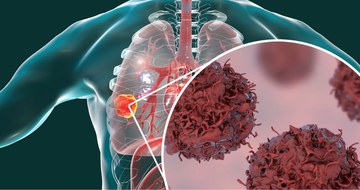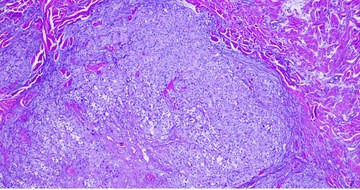Elacestrant for Hormone Receptor (HR) Positive, Human Epidermal Growth Factor Receptor 2 (HER2) negative metastatic breast cancer. Read the FDA update: Elacestrant for ER-positive, HER2-negative, ESR1-mutated breast cancer
What is the potential role for elacestrant in the treatment of metastatic breast cancer?
- Elacestrant is a novel selective estrogen receptor degrader (SERD) approved for the treatment of postmenopausal women or adult men, with estrogen receptor (ER) positive, human epidermal growth factor receptor 2 (HER2) negative, estrogen receptor 1 (ESR1) mutated advanced or metastatic breast cancer with disease progression following at least one line of endocrine therapy.1
- ESR1 mutations are found in approximately 40% of HR+/HER2- metastatic breast cancer patients and result in the estrogen receptor remaining in an active conformation, allowing estrogen-independent ER activation and resistance to estrogen blockade therapy by aromatase inhibitors. ESR1 mutations have also been associated with partial resistance to tamoxifen and fulvestrant.1,2
- ESR1 mutations are associated with worse progression free survival (PFS) and overall survival (OS).3
- Elacestrant is a first-in-class, non-steroidal, oral selective estrogen receptor degrader. The last endocrine therapy to be approved for breast cancer was fulvestrant in 2002.1,2
- Elacestrant’s mechanism varies in a dose dependent manner. At low doses, it acts as a selective estrogen receptor modulator (SERM) while at high doses it acts as a SERD.2
- While fulvestrant is given as an intramuscular injection, elacestrant offers a more convenient method via the oral route.2
- Study Design4:
- EMERALD is an international, multicenter, randomized, open-label, phase III clinical study.
- Patient population:
- Post-menopausal women or men aged 18 years or older
- Histologically or cytologically proven ER+/HER2- breast adenocarcinoma and either locoregionally recurrent or metastatic disease, including wildtype and ESR1-mutated patients.
- Disease progression after 1-2 lines of endocrine therapy for advanced/metastatic disease. Patients must have been on previous CDK4/6 inhibitor treatment in combination with fulvestrant or an aromatase inhibitor.
- Patients could only have one prior line of chemotherapy for advanced disease
- Patients with symptomatic metastatic visceral disease or certain cardiovascular events were excluded.
- Patients were randomized 1:1 to elacestrant or standard of care (SOC) therapy, which consisted of investigator’s choice of fulvestrant, anastrozole, letrozole, or exemestane, based on previous lines of therapy.
- Randomization was stratified by ESR1 mutation status, prior treatment with fulvestrant, and visceral metastasis.
- Results:
- 477 patients were randomized to elacestrant 400 mg daily (239 patients) or standard of care (238 patients).
- 115 patients had an ESR1 mutation in the elacestrant arm and 113 patients had an ESR1 mutation in the SOC arm (total 228 patients).
- Most patients had 1 prior line of endocrine therapy.
- 54% of patients in the elacestrant arm had 1 prior line of endocrine therapy versus 59.2% of patients in the SOC arm.
- 46% of patients in the elacestrant arm had 2 prior lines of therapy versus 40.8% of patients in the SOC arm.
- Very few patients had previous mTOR inhibitor or PI3K inhibitor exposure.
- 4.2% of patients had a previous mTOR inhibitor and 1.3% of patients had a previous PI3K inhibitor in the elacestrant arm.
- 2.5% of patients had a previous mTOR inhibitor and 0.4% had a previous PI3K inhibitor in the SOC arm.
- Most patients had visceral metastases: 68.2% of patients in the elacestrant arm versus 71% of patients in the SOC arm. Visceral metastases included brain, lung, liver, pleural, and peritoneal involvement.
- Primary Endpoint:
- The primary endpoint was PFS in all patients and in patients with ESR1 mutations assessed by blinded independent central review (BICR).
- PFS rate:
- The 6-month PFS rate was 34.3% in all patients with elacestrant versus 20.4% with SOC.
- The 6-month PFS rate was 40.8% in ESR1 mutated patients with elacestrant versus 19.1% in ESR1 mutated patients on SOC.
- The 12-month PFS rate was 22.3% in all patients with elacestrant versus 9.4% on SOC.
- The 12-month PFS rate was 26.8% in ESR1 mutated patients with elacestrant versus 8.2% in ESR1 mutated patients on SOC.
- PFS Hazard Ratio
- The hazard ratio for PFS in all patients was 0.70 (95% confidence interval [CI], 0.55–0.88, p = 0.002).
- The hazard ratio for PFS in ESR1 mutated patients was 0.55 (95% CI, 0.39 – 0.77, p = 0.0005).
- An exploratory analysis of PFS in the subgroup of patients without ESR1 mutations showed a HR of 0.86 (95% CI, 0.63 - 1.19), indicating that the PFS benefit in the overall population was primarily driven by the ESR1 mutated population.
- Median PFS estimates were 2.8 months for all patients in the elacestrant arm vs. 1.9 months for all patients in the SOC arm.
- Median PFS estimates were 3.8 months for ESR1 mutated patients in the elacestrant arm vs. 1.9 months for all patients in theSOC arm.
- Fulvestrant comparison
- The PFS HR of elacestrant versus fulvestrant was 0.68 (95% CI, 0.52 – 0.90, p=0.0049).
- Elacestrant demonstrated improved PFS compared to fulvestrant in all patients with a 6-month PFS rate of 34.3% versus 22.9% and a 12-month PFS rate of 22.3% vs. 10.1%.
- Secondary Endpoints:
- Secondary endpoints included investigator-assessed PFS, OS in patients with ESR1 mutations, objective response rate, and duration of response.
- Interim OS analysis demonstrated a HR of 0.75 (95% CI, 0.54 – 1.04, p=0.08) in all patients and HR of 0.59 (95% CI 0.36 – 0.96, p=0.03) in ESR1 mutated patients.
- The HR for OS in ESR1 mutated patients was not statistically significant. Mature OS data will be published at a later date.
- Secondary endpoints included investigator-assessed PFS, OS in patients with ESR1 mutations, objective response rate, and duration of response.
- Subgroup analyses favored elacestrant in ESR1 wild-type and mutated patients, 1 or 2 of lines of prior endocrine therapy, no prior chemotherapy, presence of visceral metastases, and measurable disease at baseline.
- The HR for patients with 2 prior lines of endocrine therapy was 0.59 (95% CI 0.42 – 0.84) versus 0.70 (95% CI 0.51 – 0.95) in patients with 1 prior line of endocrine therapy.
- The differences in HR may be secondary to more endocrine resistance in the second and later line setting as opposed to retained endocrine sensitivity in the first-line setting.
- The number of patients by involved visceral metastatic site and individual HR for PFS/OS for associated metastatic site were not available.
- Safety:
- Elacestrant was well tolerated with primarily grade 1-2 adverse events (AEs).
- The most common AEs across all grades were nausea (35%), fatigue (19%), vomiting (19%), decreased appetite (14.8%), and arthralgia (14.3%).
- Most common all grade lab abnormalities included hypercholesterolemia (30%), hypertriglyceridemia (27%), AST elevation (13.1%) and AST elevation (9.3%).
What role can the pharmacist play in the management of patients on elacestrant?
- Elacestrant is available as 345 mg (equivalent to 400 mg elacestrant dihydrochloride) and 86 mg (equivalent to 100 mg elacestrant dihydrochloride) tablets.1
- Coadministration with food is recommended to reduce nausea and vomiting and to improve elacestrant’s low oral bioavailability of ~10%.5
- Elacestrant administration with a high fat meal (800-1000 calories, 50% fat) increased Cmax by 42% and AUC by 22% compared to fasted administration.
- An example of a high fat breakfast includes fried eggs in butter, bacon strips, hash brown potatoes, and a glass of whole milk.6
- Dosage modifications are indicated for hepatic impairment.1
- Mild liver dysfunction (Child Pugh A) increases elacestrant AUC 1.28-fold and moderate liver dysfunction (Child Pugh B) increases AUC 1.83-fold.
- PBPK model simulations predict an AUC increase by 3-fold in patients with severe liver dysfunction (Child Pugh C). An FDA required post-marketing pharmacokinetic trial in patients with severe liver dysfunction is ongoing.
- Dose reduction to 258 mg daily is required for moderate liver dysfunction. Elacestrant should be avoided in patients with severe liver dysfunction.
- Elacestrant is metabolized primarily via CYP3A4, and to a lesser extent by CYP2A6 and CYP2C9. Significant drug interactions with concomitant CYP3A4 inhibitors and inducers may occur, and concomitant use should be avoided if possible. Pharmacists can play a key role in reviewing medication lists for significant drug-drug interactions.5
- Coadministration of elacestrant 172 mg once daily dose with strong CYP3A4 inhibitors resulted in 5.3x increase in AUC.
- Coadministration of elacestrant 345 mg once daily dose with moderate CYP3A4 inhibitors resulted in 2.3x increase in AUC.
- There are no recommendations for dose reductions for concomitant use with a CYP3A4 inhibitor or inducer.
- Elacestrant is a weak P-glycoprotein (P-gp) inhibitor and weak breast cancer resistance protein (BCRP) inhibitor.5
- Hypercholesterolemia and hypertriglyceridemia may develop with treatment.5
- Lipid profile monitoring is recommended prior to initiation and periodically thereafter.
Clinical Pearls
- Although the clinical trial evaluated elacestrant in ESR1-wildtype and ESR1-mutated patients, the FDA labeled indication is only for ESR1 mutated patients.1
- Guardant360 CDx is the FDA approved companion diagnostic test for detection of ESR1 mutations.1
- Guardant360 is a liquid biopsy test that detects ESR1 missense mutations between codons 310 and 547 on circulating tumor DNA.
- The American Society of Clinical Oncology (ASCO) recommends ESR1 testing at recurrence or progression on endocrine therapy for patients with metastatic HR+ breast cancer. Patients who retain ESR1 wild type may be retested at each subsequent progression for detection of ESR1 mutation emergence.7
- The phase I randomized, double-blind, placebo-controlled, multiple-ascending dose study of elacestrant in healthy post-menopausal women evaluated elacestrant capsules of 200 mg to 1000 mg daily for 7 days. Minimal levels of elacestrant were detected in the cerebrospinal fluid indicating low penetration of the blood-brain barrier.4
- There is an ongoing study assessing the efficacy for elacestrant and abemaciclib in brain metastases from HR+/HER2- breast cancer (ELECTRA) (NCT05386108).8
- Elacestrant is only filled by Onco360 or Biologics Specialty Pharmacy by McKesson.9
- Orserdu® Access Programs offer financial assistance for eligible patients via a co-pay program, patient assistance program, and rapid start program.10
- A social security number is not required for enrollment in the patient assistance program.
- Patients enrolled on the Rapid Start Program will receive 15 days of free drug while awaiting completion of a prior authorization or medical necessity approval.
References
1.Orserdu (elacestrant) [package insert]. Stemline Therapeutics Inc: New York, NY; 2023.
2.Bardia A, Aftimos P, Bihani T, et al. Emerald: Phase III trial of elacestrant (RAD1901) vs endocrine therapy for previously treated ER+ advanced breast cancer. Future Oncol. 2019;15(28):3209-3218. doi:10.2217/fon-2019-0370.
3.Chandarlapaty S, Chen D, He W, et al. Prevalence of ESR1 mutations in cell-free DNA and outcomes in metastatic breast cancer. JAMA Oncology. 2016;2(10):1310. doi:10.1001/jamaoncol.2016.1279.
4.Bidard F-C, Kaklamani VG, Neven P, et al. Elacestrant (oral selective estrogen receptor degrader) versus standard endocrine therapy for estrogen receptor–positive, human epidermal growth factor receptor 2–negative advanced breast cancer: Results from the Randomized Phase III Emerald Trial. J Clin Oncol. 2022;40(28):3246-3256. doi:10.1200/jco.22.00338.
5.Beumer JH, Foldi J. Pharmacology and pharmacokinetics of elacestrant. Cancer Chemother Pharmacol. Published online June 14, 2023. doi:10.1007/s00280-023-04550-7.
6.U.S. Food & Drug Administration. Assessing the effects of food on drugs in INDs and NDAs — clinical pharmacology considerations guidance for industry. Updated June 23, 2022. Accessed June 20, 2023. https://www.fda.gov/media/121313/download
7.Burstein HJ, DeMichele A, Somerfield MR, Henry NL. Testing for ESR1 mutations to guide therapy for hormone receptor–positive, human epidermal growth factor receptor 2–negative metastatic breast cancer: ASCO guideline rapid recommendation update. J Clin Oncol. 2023;41(18):3423-3425. doi:10.1200/jco.23.00638.
8.Stemline Therapeutics, Inc. Study of Abemaciclib and Elacestrant in Patients With Brain Metastasis Due to HR+/HER2- Breast Cancer (ELECTRA). ClinicalTrials.gov: NCT05386108. Updated April 14, 2023. Accessed July 1, 2023. https://classic.clinicaltrials.gov/ct2/show/NCT05386108.
9.ORSERDU Ordering and Distribution. https://www.orserduhcp.com/ordering. Accessed July 1. 2023.
10.ORSERDU Savings and Support. https://www.orserdu.com/savings-and-support/. Accessed July 1, 2023.



